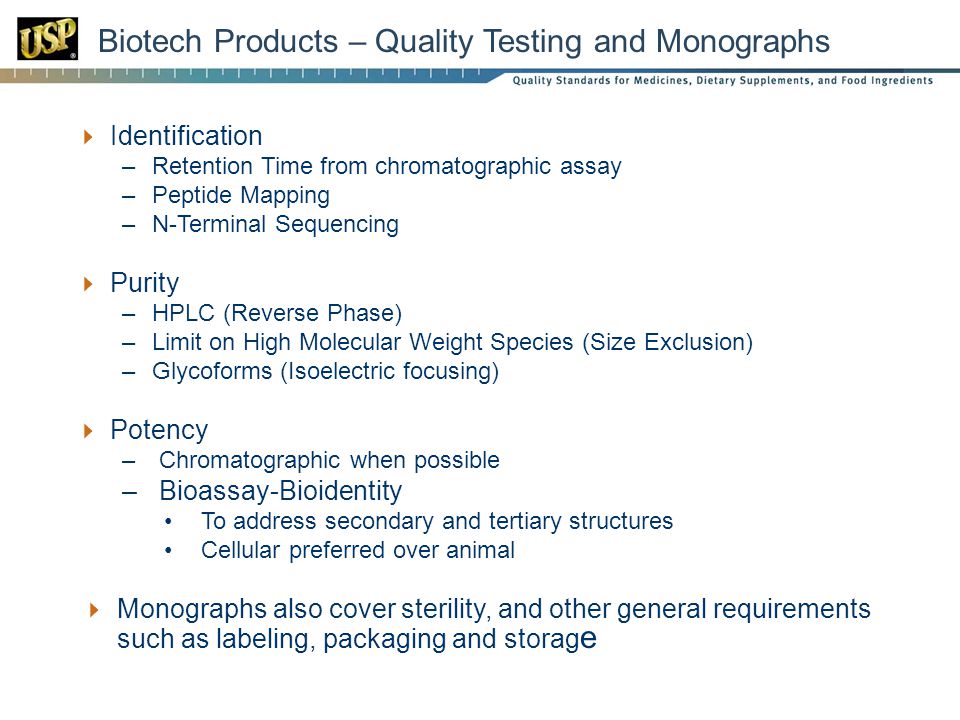Usp Monograph Filgrastim Average ratng: 3,9/5 3802 reviews
In this monograph, unless otherwise stated, the term “filgrastim products” refers to filgrastim (the reference drug), filgrastim-sndz (the biosimilar), or both drugs. Biosynthetic (recombinant DNA origin) hematopoietic agents that principally affect the proliferation and differentiation of neutrophils within the bone marrow and possibly other sites (e.g., spleen). Exert same pharmacologic effects as endogenous granulocyte colony-stimulating factor (G-CSF). Filgrastim-sndz is biosimilar to filgrastim (Neupogen ). A biosimilar is a biological that is highly similar to an FDA-licensed reference biological with the exception of minor differences in clinically inactive components and for which there are no clinically meaningful differences in safety, purity, or potency. Biosimilars are approved through an abbreviated licensure pathway that establishes biosimilarity between proposed biological and reference biological but does not independently establish safety and effectiveness of the proposed biological. Filgrastim-sndz is considered a therapeutic alternative to filgrastim; not interchangeable.

Conjugation of filgrastim with PEG results in delayed renal clearance (compared with filgrastim). Neutrophil receptor binding is an important factor in pegfilgrastim clearance. 1 Serum clearance is related to the number of circulating neutrophils; serum concentrations of the drug decline rapidly with resolution of neutropenia.
Filgrastim and tbo-filgrastim are structurally and pharmacologically similar and contain a related drug substance. Instruktazh po tehnike bezopasnosti v kabinete lfk. Tbo-filgrastim was licensed by FDA through a biologics license application (BLA), not as a biosimilar to filgrastim; at the time of tbo-filgrastim's submission for approval, FDA had not finalized a process for approving biosimilars. ASCO states that choice of a G-CSF (e.g., filgrastim, filgrastim-sndz, tbo-filgrastim) for the treatment of febrile neutropenia should be determined based upon convenience, cost, and the clinical situation. Uses for Filgrastim, Tbo-filgrastim Cancer Chemotherapy-induced Neutropenia (Filgrastim, Filgrastim-sndz, or Tbo-filgrastim) Management of cancer chemotherapy-induced neutropenia in patients with nonmyeloid malignancies receiving myelosuppressive antineoplastic therapies associated with a clinically important risk of febrile neutropenia; in clinical studies, filgrastim reduced risk of infectious complications (as manifested by febrile neutropenia) and tbo-filgrastim reduced duration of severe neutropenia. Based on demonstration of biosimilarity, no clinically meaningful differences considered to exist between filgrastim-sndz and filgrastim with respect to efficacy.
Current guidelines for the use of colony-stimulating factors (CSFs) in adults with solid tumors or nonmyeloid malignancies (e.g., lymphoma) recommend prophylaxis with CSFs based upon a patient's risk of developing febrile neutropenia following chemotherapy, taking into account the type of cancer, chemotherapy regimen, patient risk factors, and treatment intent. Prophylaxis recommended for adults with these malignancies who are at high risk of febrile neutropenia (> 20%) and can be considered for patients at intermediate risk (10–20%) if risk is due to patient risk factors and not the chemotherapy regimen. Prophylaxis is generally not recommended in patients with a low risk of febrile neutropenia (65 years of age, sepsis syndrome, ANC 10 days], pneumonia, invasive fungal infections or other clinically documented infections, hospitalization, prior episodes of febrile neutropenia). Leukemia (Filgrastim or Filgrastim-sndz) Reduction of the time to neutrophil recovery and the duration of fever following induction or consolidation cancer chemotherapy in adults with acute myeloid leukemia (AML); filgrastim designated an orphan drug by FDA for the reduction in duration of neutropenia, fever, antibiotic use, and hospitalization following induction and consolidation treatment for AML. Use of filgrastim in patients with acute leukemia has been controversial, since results of in vitro studies indicate that certain leukemic cell lines have receptors for G-CSF and that the survival, proliferation, and differentiation of the cells are supported by CSFs. Some experts state that use of filgrastim in the treatment of myeloid leukemia should be considered investigational and undertaken with caution. Some guidelines state use of CSFs may be considered in patients with AML during induction therapy for patients who are septic and have a life-threatening infection in an attempt to shorten the duration of neutropenia.
